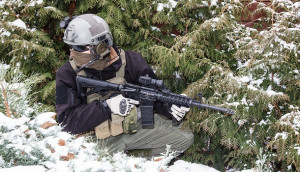
In late October, the conservative American news and political commentary website The Daily Caller reported on the dire financial straits that many American military families are facing. According to an annual survey by Blue Star Families that analyzes issues affecting military families, 40 percent of active-duty service members and their spouses feel financially insecure. The survey also found that 85 percent of respondents cited material well-being as one of the major reasons they joined the military in the first place. However, 52 percent of military personnel in all branches of the service said they are pessimistic about their future in uniform. The negative outlook is particularly pronounced among service members who joined in the wake of 9/11 and those who are nearing military retirement age. They expressed concern about their pay and access to retirement and disability benefits.
The American armed forces newspaper, Stars and Stripes, recently wrote about the health care crisis facing veterans, stating that nearly 900,000 of them have pending applications for health care. However, because of the dysfunction in the Department of Veterans Affairs and the insulting treatment of ex-military personnel, it is exceedingly difficult to pin down the precise number of applicants seeking enrollment in the VA health care system. Roughly a third of the veterans in that number are believed to have died before having their application for care processed, and lax record keeping prevents reviewers from knowing how long ago many of the applications were filed.
Retired Army Major General Robert Dees was quoted in a CNSNews.com article in which he criticized the Obama administration’s use of the military to introduce “social engineering“, adding that the president is more concerned about LGBT issues than the genuine social needs of veterans.
Under the circumstances, American military vets, particularly those with combat experience, are feeling compelled to look for an alternative, not just to obtain financial security but also to earn the respect of society. After military service or combat, they come back to a civilian life that makes them feel ill at ease. They know how to wage war, but very few of them can continue in that line of work. They feel as if they are outsiders, and they lack the social bonds needed to rejoin society and reintegrate into civilian life. They feel the urge to fall back on their combat skills and experience as well as give in to the allure of the honor in fighting enemies. Thus armed conflict is an opportunity for them to return to the life they are accustomed to and do what they know best.
That’s why American military veterans are showing up in conflict zones in Ukraine, the Middle East and elsewhere. Once the conflict begins to subside, the survivors move on to a different locale. We are now seeing many of them who had fought on behalf of the Ukrainian government heading to Syria and Iraq to offer themselves as cannon fodder. Numerous organizations are using the Internet and other tools to attract fighters with backing from Washington, which is trying to keep its support hush-hush.
This summer, U.S. Army Contracting Command announced on its website that it was seeking people with skills in logistics, planning and operations for possible deployments in Libya, Iraq, Syria and Afghanistan.
Another recruiter, the Lions of Rojava, is using Facebook to summon fighters to assorted hot spots. The group’s name is derived from the Kurdistan region that has become the front line in the Kurds’ fight against Islamic State militants. It is the most visited social networking page on the planet, drawing foreign fighters to battle IS, to which the U.S. government and the Pentagon have “entrusted” their latest war.
In such hot spots as Syria, Iraq, Afghanistan and Libya, American mercenaries often join the new Private Muslim Expeditionary Force, which is formally led by local military commanders.
There are several reasons for American officials’ efforts to recruit ex-military members to fight in non-state actions. From the Pentagon’s standpoint, doing so allows the burden imposed by veterans to be shouldered by those very same veterans and also by the recruiters, who can simply fade away once the need for their services disappears.
At the same time, this policy eliminates the problem of creating a defense contingent in countries where the United States has intervened but not gained traction in training ground forces to fight terrorists. Despite millions of dollars of American taxpayers’ money spent on training, the program utterly failed to achieve its aim in Iraq and Afghanistan. Efforts to create an armed opposition to the Assad government in Syria were also a spectacular flop, which the military brass confirmed in Senate hearings.
We now have a situation in which the number of mercenaries in Iraq and Afghanistan alone exceeds half the number of enlistees in the U.S. Army. In previous times, particularly during the Vietnam War, the ratio was about 1-to-55.
Vladimir Platov, Middle East expert, exclusively for the online magazine “New Eastern Outlook.”
